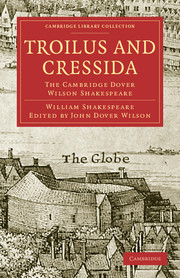THE COPY FOR TROILUS AND CRESSIDA, 1609 AND 1623
Published online by Cambridge University Press: 07 September 2010
Summary
We have two good texts of this play: the quarto of 1609 (Q.), printed by George Eld for Richard Bonian and Henry Walley, and the First Folio text of 1623 (F.).
Editors of today are fortunate, since much bibliographical work has recently been done on both texts and many problems concerning their transmission have consequently been laid to rest. As regards F., it has been shown that its position in the Folio was determined by convenience: Jaggard's first intention was that it should follow Romeo and Juliet among the Tragedies; but after three Folio pages (the beginning of the play proper) had been printed, work on Troilus was broken off and it was not resumed until after the rest of the collection (including the colophon and preliminaries) was ready. The completed text was therefore inserted between the Histories and Tragedies.
Jaggard's delay in completing this text is thought to have been due to difficulties over copyright and had printing proceeded in accordance with the original plan we should have had in F. merely a reprint of Q. The first three F. pages to be printed (the text of 1. 1. 1–1. 2. 235 above) are, in fact, derivative, the variants representing merely compositors' errors, conjectural emendations, and the usual Folio sophistications. But from the point where printing was resumed, the F. text takes on a very different character.
- Type
- Chapter
- Information
- Troilus and CressidaThe Cambridge Dover Wilson Shakespeare, pp. 122 - 134Publisher: Cambridge University PressPrint publication year: 2009First published in: 1957



